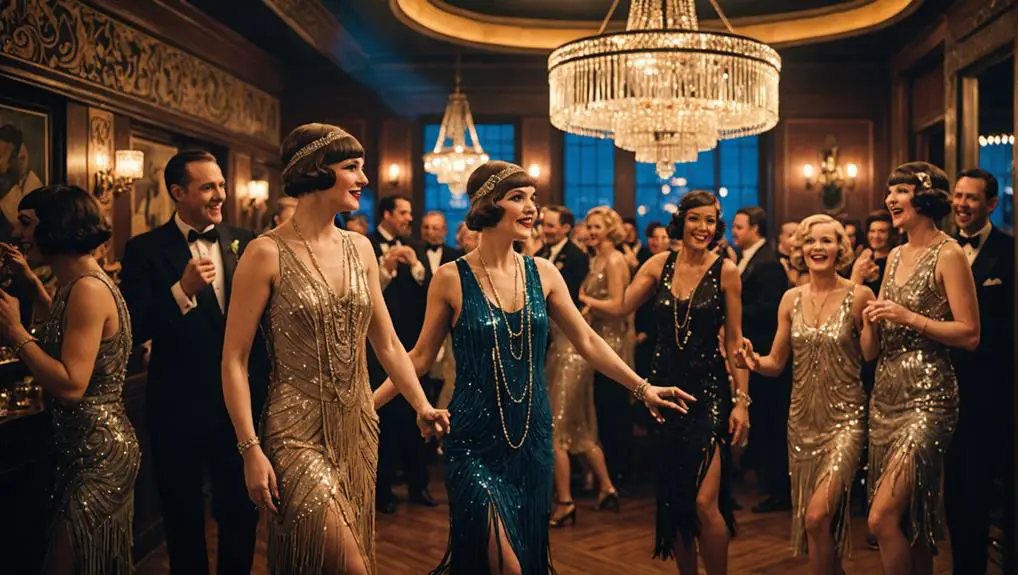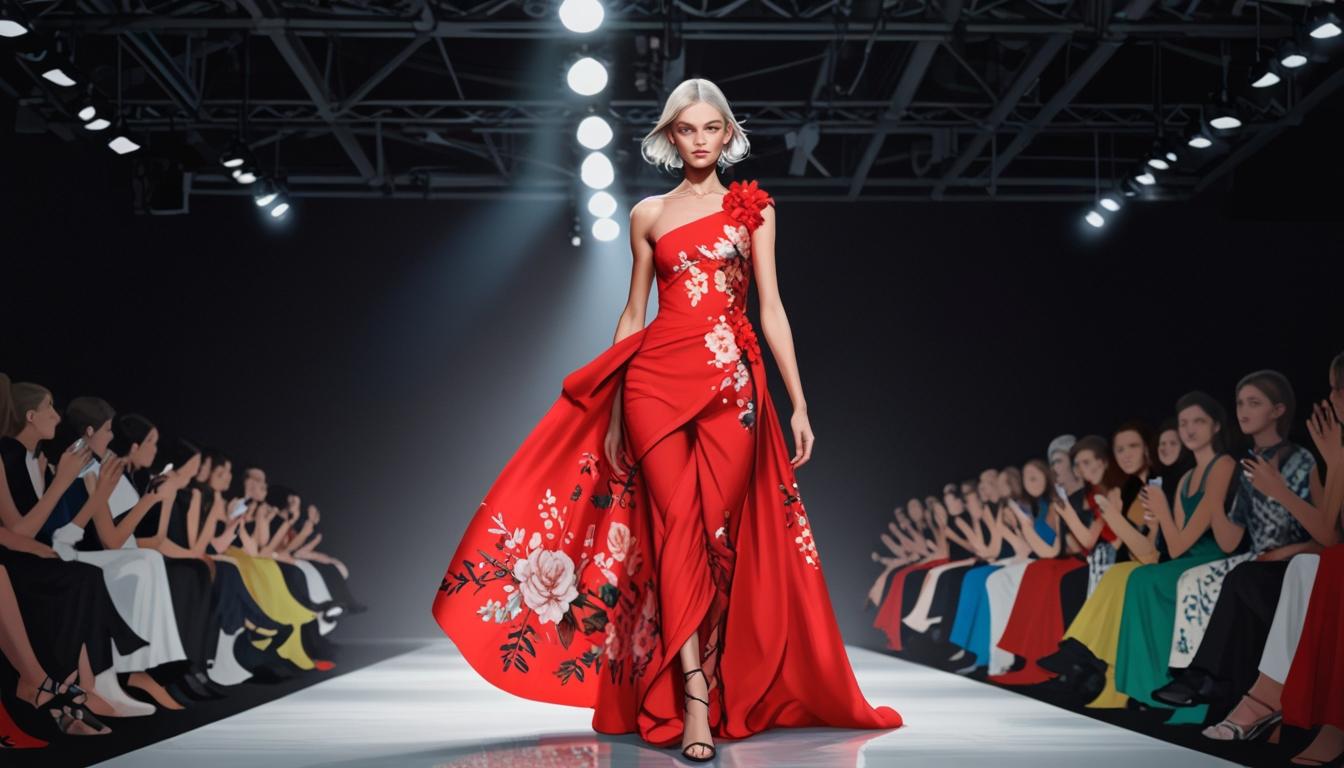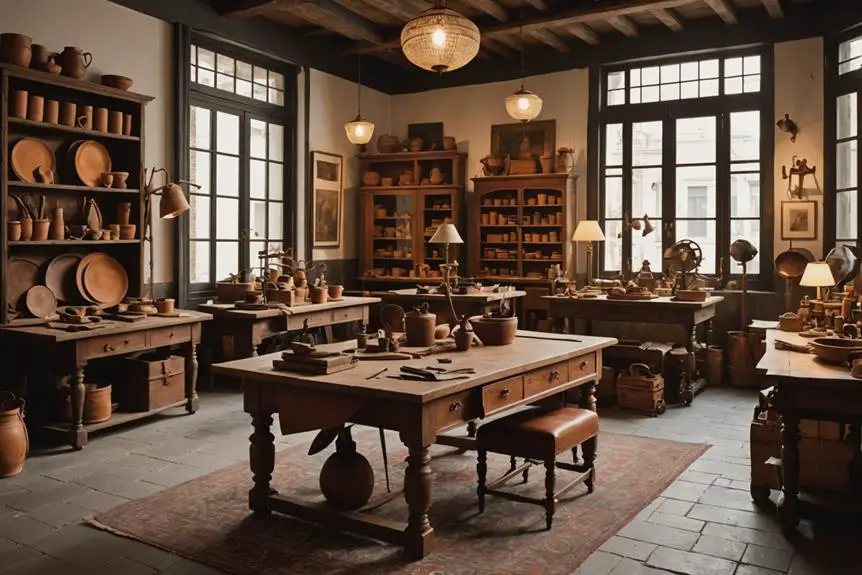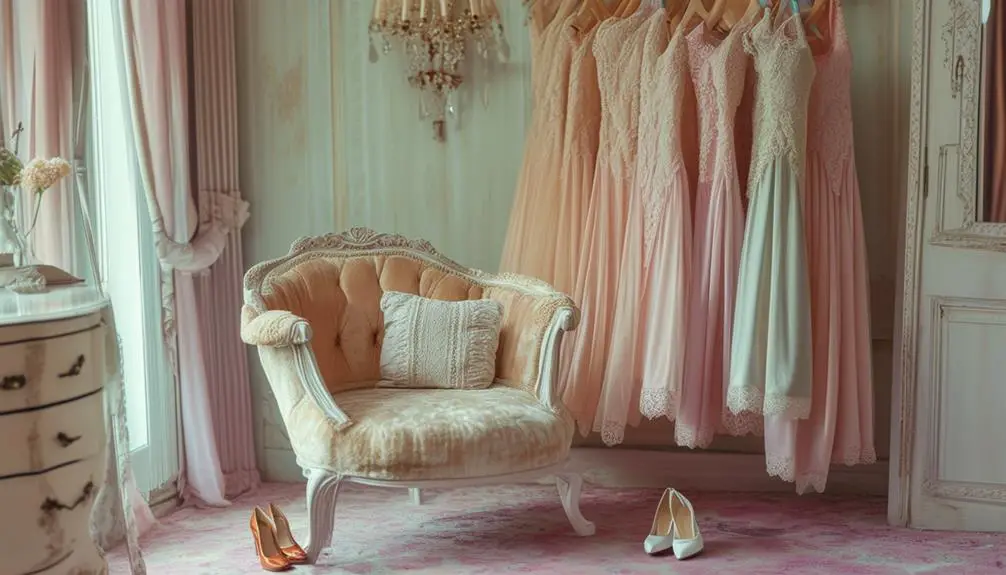Women's flapper dresses from the 1920s represent a vibrant shift in fashion and culture. They feature loose silhouettes, dropped waistlines, and dazzling embellishments like sequins and beads, emphasizing freedom and individuality. The bold color palette, with rich hues like ruby red and deep blue, reflects the era's exuberance. Flapper dresses challenged societal norms and expressed a spirit of liberation, encouraging women to embrace newfound independence. As you explore the legacy of these iconic garments, you'll uncover how they continue to influence modern fashion and remind us of their profound cultural significance.
Historical Context of Flapper Dresses
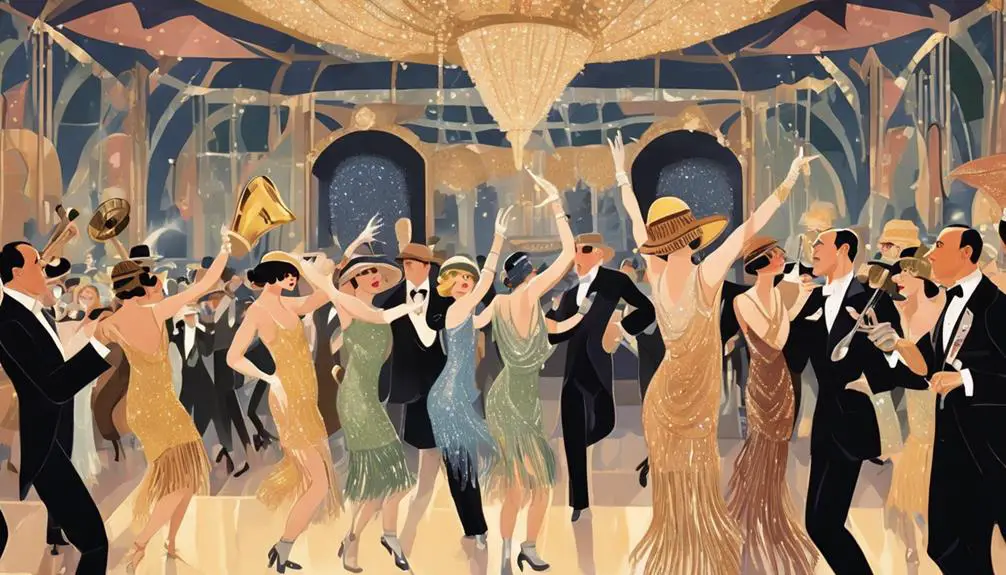
In the wake of World War I, flapper dresses emerged as a vibrant symbol of women's liberation and modernity in the 1920s. The Great Gatsby and other cultural landmarks captured this era's essence, showcasing how fashion reflected broader socio-economic shifts. As women entered the workforce in unprecedented numbers, they sought styles that echoed their newfound independence, breaking away from traditional norms. Flapper dresses, characterized by their loose silhouettes and dropped waistlines, allowed for freedom of movement—perfectly aligning with the jazz culture and social dancing that defined the Roaring Twenties. The period also saw the rise of unique vintage clothing labels, which became essential in identifying authentic pieces from this transformative time.
Coco Chanel played a pivotal role in shaping this vintage fashion movement, advocating for simplicity and comfort over opulence. Her influence helped democratize fashion, making flapper styles accessible to middle-class women who embraced the ease of home dressmaking. The flapper look, popularized around 1926, featured knee-length dresses embellished with fringe, sequins, and beads, signaling a departure from the constrictive garments of the past. This transformation not only redefined women's fashion but also mirrored the cultural revolution taking place, where individuality and self-expression became paramount in the lives of women everywhere.
Iconic Features and Designs
Flapper dresses stand out for their distinctive features that encapsulate the spirit of the 1920s. Emphasizing a boyish figure, these dresses boasted loose, straight silhouettes and dropped waistlines, marking a bold departure from the constrictive corsets of previous eras. You'll notice that common embellishments like sequins and beaded fringe adorned flapper dresses, adding both movement and a touch of glamour, perfect for the lively social dancing of the Jazz Age.
The incorporation of intricate art deco patterns, often featuring floral or geometric designs, further enhanced their vintage style. Rich colors like ruby red, emerald green, and gold not only captured attention but also reflected the exuberance of the Roaring Twenties. Practicality didn't take a backseat, as adjustable straps and zip-up side closures guaranteed comfort and ease of wear while maintaining a chic appearance.
These iconic features of flapper dresses symbolize women's newfound independence and liberation in fashion and society. They didn't just represent a change in style; they were a visual declaration of the evolving role of women during this dynamic period, making a lasting impact on women's fashion for generations to come.
Color Palette and Style Variations
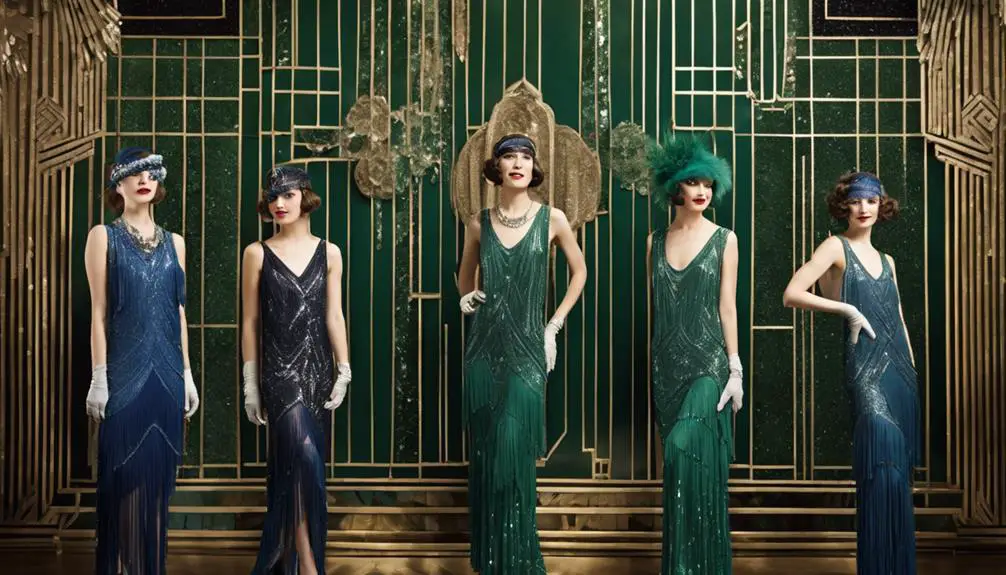
Embracing a vibrant color palette, the flapper dresses of the 1920s showcased shades like ruby red, deep blue, and emerald green, all of which reflected the decade's bold spirit and desire for freedom. Each dress became a canvas for self-expression, allowing women to embody their individuality. The Mable Black Flapper Dress, adorned with black tulle and sequins, exemplified elegance, while the Gold Fringe Flapper Dress brought a playful shimmer to the dance floor with its dazzling gold sequins.
Style variations were abundant, with designs ranging from above-the-knee to full-length, catering to diverse tastes and body types. Loose silhouettes with dropped waistlines facilitated movement, making these dresses ideal for the lively Jazz Age. Fringe detailing added an element of fun, enhancing the dresses' dynamic appeal as women twirled and danced.
Beaded embellishments and intricate art deco patterns often adorned the gowns, emphasizing glamour and allure. The combination of rich colors and unique styles allowed flappers to not only challenge societal norms but also celebrate their newfound freedom. Ultimately, the color palette and style variations of flapper dresses became a vibrant expression of the era's revolutionary spirit.
Occasions for Wearing Flapper Dresses
Whether you're attending a Great Gatsby themed party or a vintage-inspired wedding, flapper dresses serve as the perfect attire to capture the spirit of the 1920s. These stunning vintage garments, often adorned with shimmering sequins and hand beaded details, embody the glamour and excitement of the Roaring Twenties. Understanding the history behind vintage clothing labels can enhance your appreciation for these exquisite dresses, as they often reflect the era's fashion trends and brand significance, making them even more special vintage tag identification.
For themed events like jazz gatherings, flapper dresses allow you to dance freely, guaranteeing you feel comfortable while showcasing your stylish flair. Their design promotes ease of movement, making them ideal for lively celebrations. Additionally, vintage-inspired weddings frequently feature flapper dresses for bridesmaids or guests, enhancing the romantic atmosphere with a nod to the past.
Costume parties also embrace flapper dresses, as they provide an authentic touch that transports attendees back to an era of exuberance and elegance. In theatrical performances, these dresses are vital for accurately portraying the fashion of the time, enriching the visual storytelling.
No matter the occasion, flapper dresses remain a timeless choice, allowing you to embody the essence of the 1920s with sophistication and grace. Their versatility guarantees you'll always find the right moment to wear one.
Pricing and Ordering Information
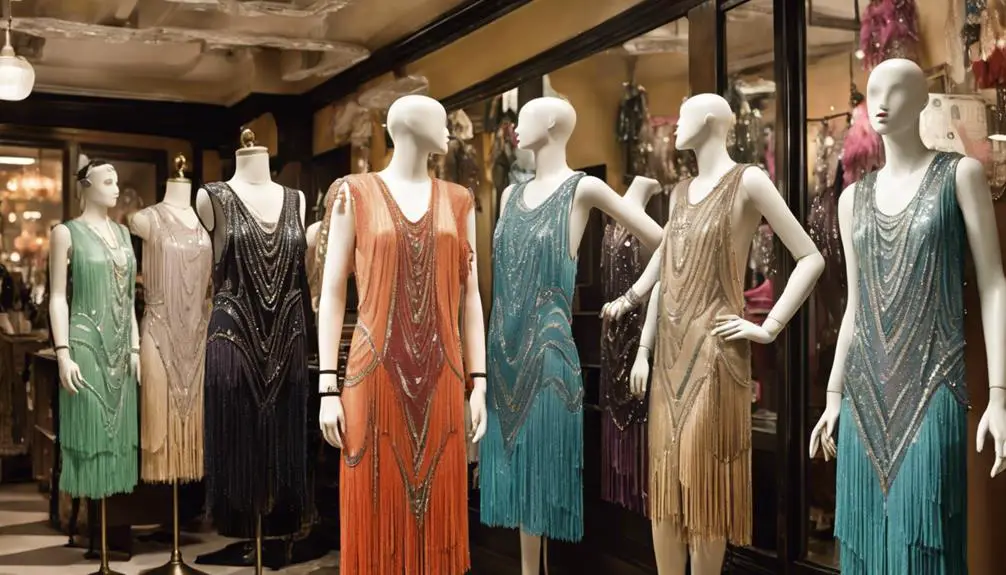
Finding the perfect flapper dress for your next event is both an exciting and affordable endeavor. With a range of flapper dresses available, you can easily find something that suits your style and budget. Most flapper dresses are priced between $68.95 and $76.95, making them great affordable options for Gatsby themed parties. If you're looking for something truly eye-catching, consider the Black Beaded Fringe Sleeve Nadine Flapper Dress, which is a bestseller at $98.
Here are some important pricing and ordering insights:
- Discounts may be available for bulk purchases or during special promotions, enhancing affordability.
- Online orders are processed the same day, ensuring a quick turnaround for your special events.
- Fast and reliable shipping options come with tracking information, so you can stay updated on your dress's journey.
When browsing for your dress, keep an eye out for sequin embellishments that add a touch of glamour. With these tips in mind, you're sure to find a stunning flapper dress that fits your budget and makes you shine at your next gathering!
Essential Accessories and Styling Tips
To truly capture the essence of the 1920s flapper style, it is essential to pair your dress with the right accessories. Start with a beaded fringe flapper dress that embodies the era's glamour. Complement this with feather boas and headbands adorned with sequins or feathers, which elevate your look while enhancing the overall aesthetic.
For your headwear, opt for a cloche hat that not only symbolizes the time but also pairs beautifully with the short hairstyles that define the flapper silhouette. Footwear trends like T-bar and Mary Jane shoes add elegance, often featuring intricate embellishments that perfectly match your dress.
Jewelry plays an important role in this ensemble; long pearl necklaces and Art Deco earrings bring a touch of sparkle. As for makeup trends, don't hold back! Bold oxblood lipstick and dramatic eye makeup reflect the flapper spirit of rebellion and self-expression.
Cultural Impact and Legacy
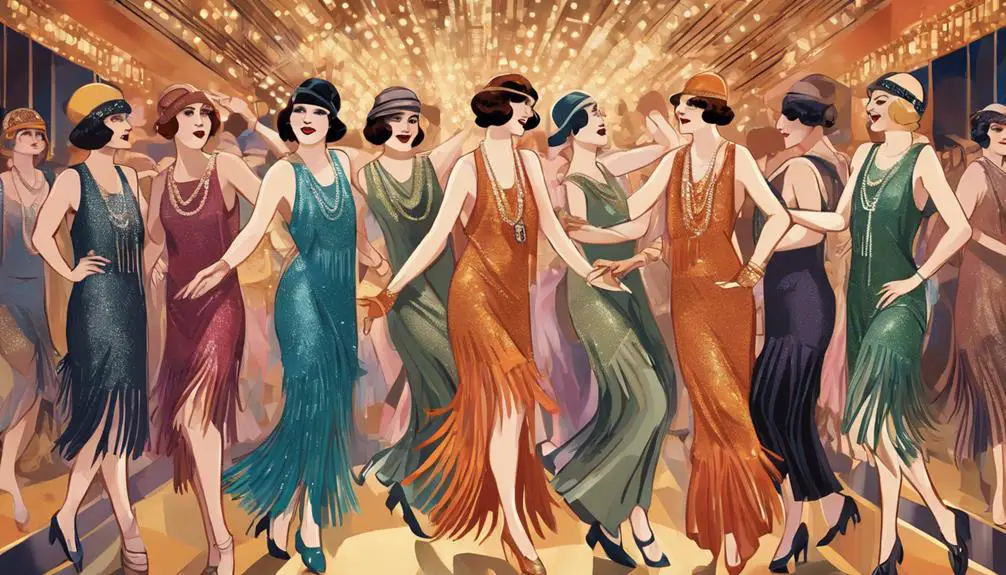
The cultural impact of flapper dresses transcended mere fashion, embodying a transformative era for women in the 1920s. These garments symbolized liberation, allowing women to break free from the constraints of traditional attire. With their shorter hemlines and looser silhouettes, flapper dresses represented a bold departure from the past, aligning closely with the rebellious spirit of the Roaring Twenties.
- Flapper culture challenged social norms, encouraging women to engage in smoking, drinking, and dancing, reshaping the very definition of femininity.
- The democratization of fashion emerged as flapper dresses became accessible to middle-class women, thanks to home dressmaking and pattern replication.
- Elements like sequins and fringe became staples, influencing modern aesthetics and inspiring contemporary designers.
The flapper dress wasn't just a piece of clothing; it was a statement. It echoed the broader social changes of the time, intertwining with women's rights movements and the quest for a more liberated lifestyle. Even today, the legacy of flapper fashion endures, reminding us of a pivotal moment when women embraced their freedom and redefined their identity within society.
Frequently Asked Questions
What Did It Mean if a Woman Was a Flapper During the 1920s?
If you're identified as a flapper in the 1920s, you embody independence and rebellion against traditional norms. You embrace social freedom, challenge expectations, and celebrate a modern lifestyle, reflecting significant shifts in women's rights and cultural expression.
What Color Dresses Did Flappers Wear?
When considering the colors of dresses flappers wore, you'd notice vibrant hues like ruby red and emerald green, alongside elegant metallics and classic black, creating a striking contrast to softer pastels for daytime elegance.
What Was the Name of the Flapper Dress in the 1920s?
You might've heard of iconic flapper dresses like the "Mable Black Flapper Dress" or the "Gold Fringe Flapper Dress." These names reflect the exuberance and liberation of a culture enthusiastic to embrace modernity and self-expression.
Why Were They Called Flappers?
You'll find the term "flapper" originated from the lively, carefree nature of young women in the 1920s, as they embraced new freedoms and defied traditional norms, often dancing energetically, making a flapping sound with their shoes.
